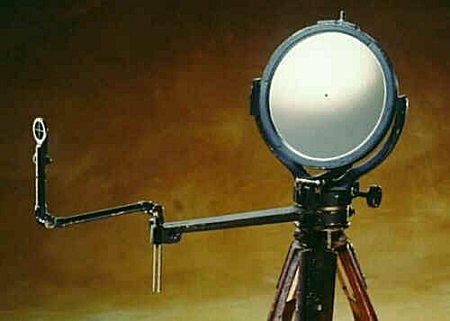Updated: 1 May 2003


The Heliograph. |
Updated: 1 May 2003 |  
|
The Heliograph was a simple but highly effective instrument for instantaneous optical communication over 50 miles or more in the 19th century. Its major uses were for military and survey work. It was still in serious use at least up to 1935, for example by Glubb Pasha's Arab Legion in Palestine.
The heliograph sent its signals by reflecting sunlight towards the intended recipient with a mirror or mirrors, the beam being keyed on and off with a shutter or a tilting mirror, allowing Morse code to be sent. Heliographs were used by the armies of several countries during the late 1800's; they were highly popular with British forces in India because of the dependable sunlight.
The classic heliograph is the Mance pattern, devised by Sir Henry Mance at Bombay in 1869. See illustration below.

| Left: A British Mark V Mance pattern 5-inch heliograph. The operating key is behind the mirror.
|
The distance that heliograph signals could be seen depended on the clearness of the sky and the size of the mirrors used. Obviously a clear line of sight was required, and the earth's surface is curved, so the highest convenient points were used. Under ordinary conditions, a flash could be seen 30 miles (48 km) with the naked eye and much farther with a telescope. You might think that reflecting a beam to hit a target 30 miles away would require some precision optical alignment- fortunately this is not so because of the finite size of the sun's disc. The maximum range was considered to be 10 miles for each inch of mirror diameter; mirrors varied from 1.5 inches to 12 inches or more.
Heliographs could be used with moonlight, but at much reduced range.
Speed was 5 to 12 words per minute, depending on the Morse skills of the operators.

| Left: The working parts of a Mance pattern heliograph.
On the minus side, the heliograph was obviously vulnerable to bad weather, and the mirrors were fragile. |
The directional transmission feature became a problem instead of an advantage when a heliograph was used from a ship under way or swinging at anchor. It was solved in British practice by adding a dispersing lens which broadened the beam out to about 15 degrees in two dimensions, at some loss of range.
USERS OF THE HELIOGRAPH
included:
HELIOGRAPH LINKS.
These links will only be checked infrequently. Please notify me if they die.
  
|